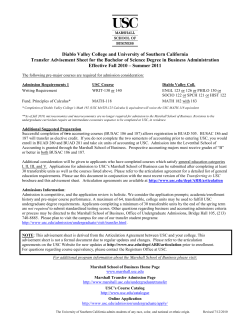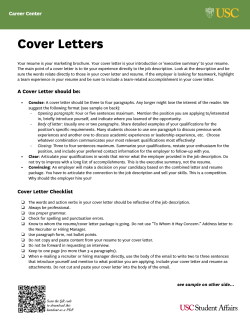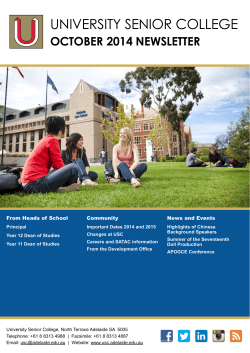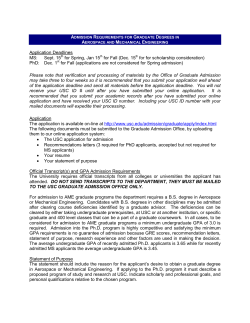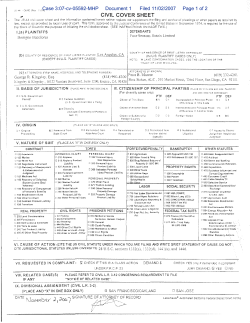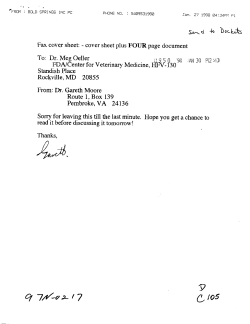
Keck School receives $11 million gift to fight diabetes, cancer
FEBRUARY 29, 2008 VOLUME 13, NUMBER 6 Keck School receives $11 million gift to fight diabetes, cancer A friend of the Keck School of Medicine has given a bequest of $11 million. In recognizing the donor’s interest in diabetes and cancer, the Clifton Stewart Diabetes Research Program will be created using half the funding. The program initially will recruit three top-level basic science investigators who will enhance the School’s clinical research strengths in diabetes and obesity. According to Keck School Dean Carmen Puliafito, a planning committee will be chaired by Thomas Buchanan, professor of medicine and obstetrics and gynecology and associate dean for clinical research, and Richard Bergman, the W.M. Keck Professor of Physiology and Biophysics, and chair of the Department of Physiology and Biophysics. Remaining gift funds will create the Clifton Stewart Cancer Research Fund, supporting basic and clinical research at the USC/Norris Comprehensive Cancer Center. “This remarkable gift from the estate of Mr. Clifton Stewart will allow our faculty to continue to shine in two priority areas of research—cancer and diabetes,” Puliafito said. “We look forward to leveraging our considerable research strengths in diabetes and obesity as we recruit new research faculty to the Keck School.” Puliafito added that the new investigators will be placed within existing basic science departments and research institutes. School of Pharmacy dominates state association awards Veronica Jauriqui By Kukla Vera USC President Steven B. Sample delivered his annual address at the HSC on Feb. 26 at the Aresty Conference Center. He praised the efforts of faculty and staff and outlined plans for an ambitious $5 billion fundraising campaign. Sample lauds faculty in annual address to campus By Ina Fried USC President Steven B. Sample painted a picture of accomplishment and optimism when he spoke Feb. 26 to a standing-room-only audience of faculty and staff at the Aresty Conference Center on the Health Sciences Campus. “Many people are responsible for USC’s recent accomplishments, but first in line would be our faculty, whose dedication and hard work have played a major role in USC’s moving into the top tier of research universities. Thanks to the efforts of our faculty over the last two decades, USC has come farther faster than any other university in the United States,” Sample said. He outlined dramatic new directions throughout the university, including preliminary planning for a new $5 billion fundraising campaign. This “audacious goal” follows USC’s successful Building on Excellence campaign, which concluded at the end of 2002, raising nearly $3 billion. At that time, it was the most successful fundraising campaign in the history of higher education. Since then, USC has raised nearly $2 billion in new gifts. In the past fiscal year alone, USC raised $470 million in cash and in-kind gifts received—not pledges—which ranked USC third in the nation after Stanford and Harvard. Sample described a university in the midst of transformation—with a massive physical expansion, a change from a primarily commuter institution to a residential university, changes in leadership through the appointment of a number of new deans and administrators, and new academic initiatives that enrich the intellectual environment. “I’m very optimistic about the future of the Keck School of Medicine under the leadership of its new dean Dr. Carmen Puliafito,” Sample said. “This school accounts for nearly half of USC’s sponsored research, and through its clinical programs the school directly touches the lives and well-being of more than a million people every year.” Sample praised the Keck School for its success in partnering with Childrens Hospital Los Angeles to attract $24 million in grants from the California Institute for Regenerative Medicine, or CIRM. USC/CHLA now ranks third in the state in winning grant support from CIRM after Stanford and the University of California at San Francisco. “We’ve recruited a number of outstanding researchers, who are leading the charge and putting USC on the map in stem cell research,” he said. Mel Baron, associate professor at the School of Pharmacy, was named “Pharmacist of the Year,” and Pharm.D. student Danielle Colayco won “Student of the Year” at the California Pharmacists Association annual meeting Feb. 8 in Sacramento. The California Pharmacists Association (CPhA) identifies the Pharmacist of the Year as the highest award that the association grants. Baron, who joined the USC faculty in 1980 and graduated from the school in 1957, was recognized for his work as an educational futurist and a regional force in meeting pharmacy needs of the community. Baron’s long and varied career has been characterized by new approaches to meeting needs. In the 1980s, Baron was a national leader in offering firstyear students clinical experiences, known as externships, before most schools were providing any hands-on opportunities to students during the early years of their pharmacy education. This set a national standard of expanded experiential education for pharmacy students nationwide. Baron also pioneered the role of the clinical pharmacist in safety-net clinics in Los Angeles, serving the needs of the area’s uninsured residents. Baron recognized that expanded pharmacy services in these settings could greatly increase the number of patients seen while providing better care and saving health-care dollars. In 2000, he spearheaded the school’s first funding grant for safety-net clinic work, which today has grown to expanded services in multiple locations serving some of L.A.’s See AWARDS, page 4 Center for Community Translation receives $1 million to improve healthcare access By Katie Neith Building on the USC legacy of giving back to the community, researchers from the Keck School of Medicine, Childrens Hospital Los Angeles and LAC+USC Medical Center have received over $1 million to support a Center for Community Translation (CCT). A three-year, $900,000 grant from the UniHealth Foundation has been awarded to co-primary investigators Michele Kipke, professor of pediatrics and preventive medicine at the Keck School of Medicine and director of the CCT, and Thomas Buchanan, professor of medicine and obstetrics and gynecology at the Keck School and director of the General Clinical Research Center at LAC+USC Medical Center. The CCT will foster partnerships between academic institutions and community-based healthcare organizations to improve access to and quality of health care in local communities. It is part of a broader National Institutes of Health consortium that has funded the Los Angeles Basin Clinical and Translational Science Institute (CTSI), a partnership among USC, Childrens Hospital, City of Hope and Kaiser Permanente. The CTSI develops and supports interdisciplinary and collaborative research that moves scientific discoveries to applications in human health and health care, with particular emphasis on the health of diverse urban populations in and around Los Angeles. “There is a current trend to look at how academic institutes can partner with a range of different community stakeholders so what we learn in research can be translated into general practice,” said Kipke, who also serves as a program director and associate director of The Saban Research Institute of Childrens Hospital Los Angeles. “When I say community, I mean faith communities, residents, local leaders, elected officials, policy makers, etc. At academic institutions, we tend to do research in a vacuum. The CCT is part of a growing momentum to create new models and influence change that will improve health at a community level.” Three programs that will be funded by the UniHealth grant include a cancer-related surveillance system, continuity of care for the chronically ill and evaluation of patient navigators, used to insure integration and continuity of both primary health care and mental health services. These projects are being conducted in partnership with USC faculty and the Los Angeles County Department of Health Services and the Department of Mental Health. Kipke is also the primary investigator on an additional $200,000 grant from the Lincy Foundation, which aims to promote community efforts via the CCT to improve early identification and intervention efforts for mental health and substance abuse disorders in Los Angeles communities. “These two grants will help us initi- Phone: 323-442-2830 Fax: 323-442-2832 Email: hscwkly@usc.edu Web: uscnews.usc.edu/hscweekly/ HSC Weekly is published for the faculty, staff, students and community of the University of Southern California’s Health Sciences Campus. It is written and produced by the Health Sciences Public Relations and Marketing staff. Comments, suggestions and story ideas are welcome via the contact points listed above. Permission to reprint articles with attribution is freely given. Assoc. Senior Vice Pres., Health Sciences Public Relations and Marketing: Jane Brust Executive Director of Communications and Marketing: Ina Fried Editor: Jon Nalick ate the CCT and engage the community in a bi-directional and meaningful research partnership for the purpose of improving health,” said Kipke. “It’s our effort to move scientific findings and best practice into general practice.” ETCETERA John T. Nicoloff, professor of medicine and senior associate chair for scientific affairs in the Department of Medicine, reported that “five of our faculty have just been notified that they have been elected to the WSCI. This must be some kind of record!” Those who were inducted at the Jan. 31 meeting include Janice Liebler, Chaim Jacob, Brenda Jones and Howard Hodis—as well as Laurie DeLeve who received the organization’s Outstanding Investigator Award. The WSCI is the major general medical research organization in the Western United States. Next Issue: March 7 Senior Vice President, University Relations: Martha Harris Contributors: Eva Blaauw, Jennifer Chan, Veronica Jauriqui, Meghan Lewit, Katie Neith, Kukla Vera and Jon Weiner USC artificial retinal implant project readies expansion into Europe By Jon Weiner USC and Second Sight Medical Products Inc., the developer of retinal prostheses for treating blindness, are expanding the clinical trial of an advanced retinal prosthesis into Europe. This announcement follows the completion of enrollment in the first phase of a U.S. Food and Drug Administration-approved clinical study of the Argus II Retinal Prosthesis System, created by Mark Humayun, professor of ophthalmology and biomedical engineering at the Keck School of Medicine of USC, Doheny Eye Institute and the Viterbi School of Engineering. Studies are continuing in Mexico. “The pioneering efforts of the individuals who participate in this clinical trial will lead to advances for the many people in the world afflicted with blindness,” said Humayun, the first physician to perform an Argus II implantation procedure in the U.S. Humayun was the vitreo-retinal surgeon for the first generation 16-electrode (Argus™ 16), which he implanted between 2002 and 2004 in six patients with retinitis pigmentosa. The study demonstrated the ability of participants to detect when lights are on or off, describe an object’s motion, count discrete items, as well as locate and differentiate basic objects in an environment. The Argus II is the second generation of an electronic retinal implant designed for the treatment of blindness due to retinitis pigmentosa, a group of inherited eye diseases that affect the retina (the ultra-thin layer of cells at the back of the eye). The Argus II implant consists of 60 electrodes attached to the retina. These electrodes conduct information from an external camera to the retina to provide a rudimentary form of sight to patients with the implants. The development of this technology was largely supported by the National Eye Institute of the National Institutes of Health, and the Department of Energy’s (DOE) Office of Science Artificial Retina Project, which is helping to advance the implant’s design and construction. The unique resources and expertise at DOE national laboratories—particularly in engineering, micro- fabrication, material science and microelectronic technologies—are yielding much smaller, higher resolution devices. “We are pleased that Second Sight, along with our fantastic clinical partners, was able to fully enroll the U.S. trial in a timely manner,” said Robert Greenberg, president and CEO of Second Sight and a leader in the field of retinal prostheses for more than 15 years. “Although it is too early to comment on the clinical data, each device continues to function as expected, and all participants are using their systems at home daily.” Ten subjects have been recruited for the Argus II Phase I trial at four leading ophthalmic centers throughout the U.S., including the Doheny Eye Institute at USC, the Wilmer Eye Institute at Johns Hopkins University (Baltimore), the University of California at San Francisco and the Retina Foundation of the Southwest (Dallas). Second Sight will be seeking expansion of the U.S. trial to include other trial sites located in New York (Columbia University Medical Center and Lighthouse International), Philadelphia (Scheie Eye Institute and Wills Eye Hospital) and Atlanta (Emory University and Atlanta V.A. Rehab R&D Center). This three-year trial is the only longterm study of a retinal prosthesis currently being conducted anywhere in the world. Internationally, the Argus II study began in Mexico in the fall of 2006. More recently, enrollment has begun at two European sites in Geneva, Switzerland, and Paris, France. A third study site at Moorfields Eye Hospital in London has recently received government approval and is expected to begin enrollment shortly. “We are excited about the progress being made in the development of this artificial retina technology,” said Stephen Rose, chief research officer, Foundation Fighting Blindness. The foundation supported early preclinical studies of this technology, because of its potential for giving vision to people with the most advanced retinal disease, Rose said, and “we are pleased to have helped advance the prosthesis into critical clinical trials.” Calendar of Events The HSC Calendar is online at www.usc.edu/hsccalendar 9 A.M. Current Issues in Cosmetic Dermatology. “Topical Therapy for Photoaging,” David Woodley, USC. KAM Mayer Aud. Info: (323) 442-2555 9:30 A.M. Current Issues in Cosmetic Dermatology. “Photodynamic Therapy for Photoaging,” Han Lee, USC. KAM Mayer Aud. Info: (323) 442-2555 10 A.M. Current Issues in Cosmetic Dermatology. “Chemical Peels for Photoaging,” Manju Vadmal, USC. KAM Mayer Aud. Info: (323) 442-2555 10:40 A.M. Current Issues in Cosmetic Dermatology. “Treatment of Leg Veins with Sclerotherapy,” Justine Park, USC. KAM Mayer Aud. Info: (323) 442-2555 11:10 A.M. Current Issues in Cosmetic Dermatology. “Treatment of Leg Veins with Laser Light,” David Sawcer, USC. KAM Mayer Aud. Info: (323) 442-2555 11:40 A.M. Current Issues in Cosmetic Dermatology. “An Algorithm for Treating Rosacea,” David Peng, USC. KAM Mayer Aud. Info: (323) 442-2555 Elaine Kaptein, USC. GNH Drs. Dining Rm. A & B. Info: (323) 226-7307 3 P.M. Hoyt Art Gallery Reception. KAM Basement Lobby. Info: (323) 442-3429 4 P.M. “Research in Progress,” Nasimeh Yazdani, GNH 10-340. Info: (323) 226-7307 Tuesday, Mar. 4 9 A.M. Neurology Grand Rounds. “Innate Immunoregulatory Cells: Contribution to the Link between Infections,” Roelof van der Veen, USC. ZNI 112. Info: (323) 442-7686 9 A.M. Ctr. for Transdisciplinary Research on Energetics and Cancer. “Novel Methods to Process and Interpret Accelerometer Data to Assess Physical Activity,” Patty Freedson, Univ. of Massachusetts/ Amherst. CSC 250. Info: (323) 442-4101 11:30 A.M. Psychiatry Grand Rounds. “Treating Depression in the Perinatal Period,” Emily Dossett, USC. ZNI 112. Info: (323) 226-5572 NOON. Cancer Ctr. Grand Rounds. “Variation at 8q24 & Cancer Risk,” Chris Haiman, USC. NOR 7409. Info: (323) 865-0801 Monday, Mar. 3 Wednesday, Mar. 5 NOON. Fellows’ Didactic Teaching Conference. “RTA: Case Discussion,” “Studying the Molecular Mechanisms of Down Syndrome: Drosophila as a Model System,” Karen Chang, Indiana Univ. ZNI 112. Info: (323) 442-3219 NOON. Renal Grand Rounds Conference. “New Antimicrobials to Treat Urinary Tract Infections: Bad Bugs – No Drugs,” Anne Anglim, USC. GNH 6441. Info: (323) 226-7307 Thursday, Mar. 6 NOON. Cellular Homeostasis Lecture Series. “Estrogen-related Receptor Function in Energy Homeostasis,” Anastasia Kralli, Scripps Research Inst. MCH 156. Info: (323) 442-3121 USC hosted the second annual University-Community Dialogue on Feb. 26 to discuss strategies to improve birth outcomes for African-American women. Co-hosted by the Pasadena Birthing Project, the event aims to increase awareness of racial disparities in infant mortality in the U.S. Above, from left, are health activists Glovioell Rowland and Wenonah Valentine, Julianne Hines, representing Assemblyman Anthony Portantino’s office, and Jack Turman, associate professor of biokinesiology and physical therapy and cell and neurobiology, who is also director of the Keck School’s Center for Premature Infant Health and Development. Rowland, Valentine and Turman display commendations from Portantino for their work. AWARDS: CPA recognizes USC faculty, student Continued from page 1 Friday, Mar. 7 8 A.M. – 5 P.M. The Twentieth Annual Occupational Science Symposium. “Autism in Everyday Life: An Interdisciplinary Venture,” Various speakers. Radisson Hotel Los Angeles. Info: (323) 442-1861. NOON. Pharmacology and Pharmaceutical Sciences Seminar. “Pharmacokinetic Modeling and Simulations to Improve the Design of Intravitreal Corticosteroid Implants for Treating Retinal Diseases,” Michael Robinson, Allergan Inc. PSC 104. Info: (323) 4421405 NOON. ZNI Faculty Candidate Seminar. Notice: Deadline for calendar submission is 4 p.m. Monday to be considered for that week’s issue—although three weeks advance notice of events is recommended. Please note that timely submission does not guarantee an item will be printed. Send calendar items to HSC Weekly, KAM 400 or fax to (323) 442-2832, or e-mail to eblaauw@usc.edu. Entries must include day, date, time, title of talk, first and last name of speaker, affiliation of speaker, location, and a phone number for information. HSC NEWSMAKERS Veronica Jauriqui Saturday, Mar. 1 neediest patients. Working in underserved areas, Baron realized that there was a void of print material to educate Spanish-speakers on health topics. Baron has produced fotonovelas, English and Spanish comic books, addressing the need for folic acid in women of childbearing age and the myths surrounding diabetes. Currently, he is in production on two additional fotonovelas on pediatric asthma and depression. According to Dean R. Pete Vanderveen, “Pioneering vision—complemented by hard work—are the distinguishing marks of the long, stillvibrant career of Dr. Mel Baron.” Taking the Association’s highest student honor is Danielle Colayco, a fourth-year Pharm.D. candidate at the School of Pharmacy. Colayco was nominated to represent USC in the statewide competition by peers and faculty. Her extraordinary record of professional pharmacy activities and community outreach garnered her the California title. “I believe this award is a testament to the incredible mentors I have in my life and to my peers who inspire me to continue fighting for our profession,” said Colayco, who plans to continue her pharmacy education next year in either a residency or fellowship program. Colayco served as the 2006-07 chapter president for the American Pharmacy Student Alliance, the umbrella organization for the four primary pharmacy groups on campus. During her presidency, Colayco coordinated health fairs, legislative advocacy, professional development and other activities. Colayco is planning a career in the pharmaceutical industry. The School of Pharmacy also won the Project Hypertension Award, with the effort led by students Helen Lee and Crista Qi. The Pharmacy Foundation of California Film Festival announced USC as the first-place winner for the best presentation on medication errors. Bonnie Hui was the lead on the winning video project. Complete listing at: www.usc.edu/uscnews/usc_in_the_news/ On Feb. 25, NPR’s “All Things Considered” interviewed obesity researcher Amytis Towfighi on her new study that found an increase in obesity rates among U.S. women coinciding with an increase in strokes. WebMD, U.S. News and World Report, the Associated Press, Reuters, HealthDay News, the Washington Post, Forbes Online, WKYC-TV, All Headline News, CTV and Xinhuanet ran similar stories. On Feb. 25, KNBC-TV Channel 4 interviewed health ethics expert David Goldstein about healthcare reform. In the Feb. 25 issue of Healthbeat Magazine, a story quoted pain management expert Steven Richeimer about back pain. Cardiothoracic surgeons Michael McFadden and Vaughn Starnes were quoted in a separate article on surgical implants. A third story included Doheny oph- thalmologist David Huang in an article about lasik eye surgery. On Feb. 21, ABC News quoted diabetes expert Anne Peters about whether embryonic stem cells can be used to effectively treat diabetes. A Feb. 20 San Gabriel Valley Tribune article quoted exercise expert Allan Abbott about the health of an 85-year-old marathon runner. A Feb. 20 Medical News Today article noted that the LAC+USC Medical Center received full accreditation by the Joint Commission. City News Service also noted the accreditation. A Feb. 19 Las Vegas Review-Journal quoted associate dean of admissions, Erin Quinn, on USC’s Baccalaureate/MD program. USC Health Sciences Public Relations 1975 Zonal Ave. KAM 400 Los Angeles, CA 90033 Non-Profit Organization U.S. POSTAGE PAID University of Southern California
© Copyright 2025

